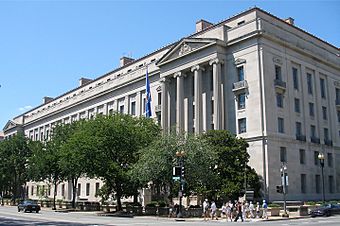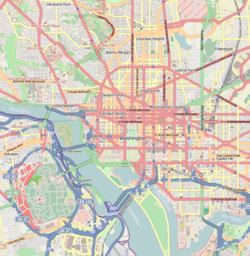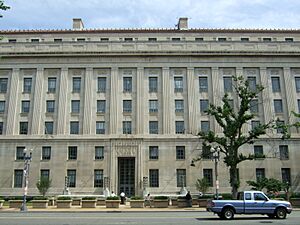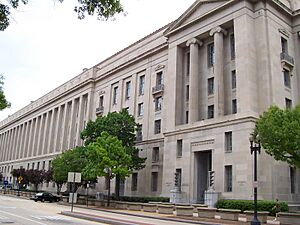Robert F. Kennedy Department of Justice Building facts for kids
Quick facts for kids |
|
|
Robert F. Kennedy Department of Justice Building
|
|
|
U.S. Historic district
Contributing property |
|

The Robert F. Kennedy Department of Justice Building in August 2006.
|
|
| Location | 950 Pennsylvania Avenue, and Constitution Avenue, NW Washington, D.C. |
|---|---|
| Built | 1935 |
| Architect | Milton Bennett Medary; Charles L. Borie, Jr.; Clarence C. Zantzinger. |
| Architectural style | Classical Revival |
| Part of | Pennsylvania Avenue National Historic Site (ID66000865) |
The Robert F. Kennedy Department of Justice Building is the main office for the United States Department of Justice. This department is a part of the U.S. government. It makes sure that laws are followed and that justice is fair for everyone.
The building is in Washington, D.C., at 950 Pennsylvania Avenue NW. It's part of a special area called the Federal Triangle. This area has many important government buildings. The building has seven floors and is very large. It holds offices for many people who work for the Department of Justice. This includes the United States Attorney General, who is the head of the department. The building was finished in 1935. In 2001, it was named after Robert F. Kennedy, who used to be the Attorney General.
Contents
History of the Justice Building
Building the Headquarters
The job of the Attorney General started way back in 1789. By 1792, the Attorney General became a top advisor to the President. In 1870, President Ulysses S. Grant created the Department of Justice. For a long time, the Attorney General and the Department of Justice didn't have their own building. They moved between different temporary offices. Plans for a permanent home began in 1910, but real progress started in the late 1920s.
In 1928, Congress allowed the government to buy land for new offices. This was part of a big building project. The government started hiring private architects to design federal buildings. This led to many new buildings, including those in the Federal Triangle. This area covers about 70 acres between the Capitol and the White House. Architects worked together to design buildings that fit each government group. They also wanted the buildings to look grand and important.
Milton Bennett Medary was chosen to design the Department of Justice Building. When he passed away in 1929, his partners, Charles L. Borie, Jr. and Clarence C. Zantzinger, took over.
In 1930, Congress set aside $10 million for the building. Construction happened from 1931 to 1934. When it was finished in 1935, the building finally gave the Attorney General and the Department of Justice a permanent home. About 1% of the building's cost was used for art. Between 1935 and 1941, 68 beautiful murals were painted inside. These murals are examples of art created during the New Deal era.
After Construction
In 1966, the Department of Justice building was added to the National Register of Historic Places. This list includes important historical sites across the country.
In 1974, the Federal Bureau of Investigation (FBI) moved out. They had been in the same building but moved to their own headquarters. Their new building is the J. Edgar Hoover Building, right across the street.
Building Updates and Renovations
From 1998 to 2006, the building went through major updates. Workers fixed the plumbing, electrical wiring, and heating and cooling systems. They also updated the elevators. The project made sure the building's original lighting and decorations were kept. A new conference center and data room were built. The main library and important executive offices were also restored.
This renovation was a big job. The building had to stay open while work was happening. Workers also had to safely remove old, dangerous materials like asbestos and lead paint. Security was very important because the building holds sensitive information. Construction workers had different levels of access to keep everything safe. The many murals and sculptures inside were protected during the work. Special controls kept the temperature, humidity, and dust levels safe for the artwork.
The renovations cost $142 million. But the project actually came in under budget! This was partly because they chose to fix some parts instead of tearing them down. For example, they repaired the courtyard and garage structures. They reused 95% of the existing materials. Old cobblestone blocks in the courtyard were cleaned and put back. The original foundation of a fountain was saved, and its pipes were replaced. These efforts saved a lot of money and reduced waste.
Because of these savings, the government could do even more work. They repaired the outside limestone walls and fixed the roof. They also restored old paintings and plaster. More hazardous materials were removed, and fire safety systems were updated. In the end, nearly $1 million was returned to the government.
Renaming the Building
In 2001, the building got a new name. It became the Robert F. Kennedy Department of Justice Building. This was to honor Robert F. Kennedy. He was the Attorney General from 1961 to 1964. He served under his brother, President John F. Kennedy, and then President Lyndon B. Johnson. Later, Robert F. Kennedy became a U.S. Senator for New York. He was running for president when he was sadly assassinated in 1968.
President George W. Bush officially renamed the building on November 20, 2001. This day was Robert Kennedy's birthday. Attorney General John Ashcroft also spoke at the rededication.
Today, the building still looks much like it did when it was first built. The outside walls, lobbies, hallways, library, and main offices have their original design. They also feature a lot of special aluminum decorations.
Building Design and Style
The building's design mixes two styles: neoclassical (like ancient Greek buildings) and Art Deco. It looks similar to other buildings in the Federal Triangle. It has a light-colored limestone outside over a steel frame. It also has a red-tiled roof and rows of columns. Inside, there are courtyards that let in natural light and fresh air.
A special message is carved on one side of the building. It says: "Justice is founded in the rights bestowed by nature upon man. Liberty is maintained in security of justice."
What makes this building stand out are its Art Deco details. It also uses aluminum in new ways. Usually, these details would be made from bronze. But here, they are aluminum. The main entrances have 20-foot-high aluminum doors that slide into the walls. Inside, the stair railings, decorative grates, and door frames are all aluminum. Even the tall, decorative lights (called torchieres) and the doors for the 25 elevators are made of aluminum. There are over 10,000 aluminum light fixtures!
The building has many unique rooms. These include the Great Hall entry area and the Law Library. The Great Hall is two stories tall. It has Art Deco lights and a floor made of terra-cotta tiles with gray marble edges. The Law Library is on the fifth floor and is also two stories high. It has two tall Art Deco lights and a large mural with 20 panels by Maurice Sterne.
Art and Sculptures
The Robert F. Kennedy Department of Justice Building has the largest collection of historic art of any building built by the General Services Administration. Sculptures are a big part of the building's design. Sculptors C. Paul Jennewein and Warren Straton created 57 sculptures for the building. Their work includes carved limestone figures on the outside walls and the aluminum Art Deco lights inside.
The inside of the building has many colorful wall paintings. These murals show scenes from American history. They also show ideas about justice in American society. In total, 68 murals were finished between 1935 and 1941. They cost $68,000, which was one percent of the building's total cost. Famous artists like George Biddle and John Steuart Curry painted these murals.
You can also see bright, colorful concrete mosaics on the ceilings of the entryways. These were made by John Joseph Earley, a master craftsman from Washington, D.C. He was known for using concrete in artistic ways. These mosaics are still very vibrant today.
On the south side of the building, there is a sculpture of Nathan Hale. He was a hero from the Revolutionary War. This sculpture was made by Bela Pratt.
Images for kids











